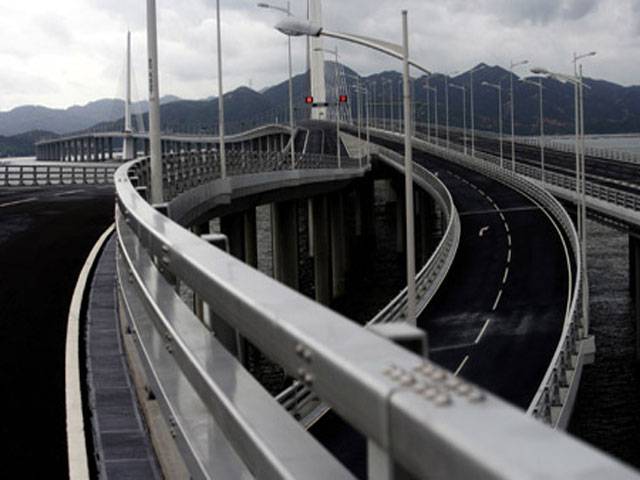I was in Shenzhen, China during the recent months of June and July. Being a Pakistani and being familiar with the type of life and environs and governance we have in Pakistan, my stay in China was nothing short of total amazement. Having achieved freedom after us China has gone miles ahead of us, in every field and every sphere of life, shame on our rulers who visit China every other day but learn nothing. I am writing a few words about the city where I stayed mainly in China. The city is on the list of UNESCO Creative Cities.
Earliest known ancient records that carried the name of Shenzhen (previously known as Bao'an County), dates from 1410 during the Ming Dynasty. Local people called the drains in paddy fields “zhen”. Shenzhen literally means “deep drains” as the area was once crisscrossed with rivers and natural streams, with deep drains within the paddy fields.
Human habitation in Shenzhen dates back to ancient times. The earliest known archaeological remains so far unearthed are shards from a site at Xiantouling on Mirs Bay, dating back to 5000 BC. From the Han Dynasty (third century BC) onwards, the area around Shenzhen was a centre of the salt monopoly, thus meriting special Imperial protection. Salt pans are still visible around the Pearl River area to the west of the city and are commemorated in the name of the Yantian container terminal meaning “salt fields”.
Shenzhen was also involved in the events surrounding the end of the Southern Song Dynasty (1276–79). The Imperial court, fleeing Kublai Khan's forces, established itself in the Shenzhen area and the last Emperor died here. Shenzhen has seen its population and activity develop rapidly since the establishment of the SEZ (Special Economic Zones). Shenzhen's population is roughly ten million. About six million of these people are migrant workers who return home on the weekends and live in factory dormitories during the week. Shenzhen is the largest migrant city in China.
There had been migration into southern Guangdong and what is now Shenzhen since the Southern Song Dynasty (1127–1279) but the numbers increased dramatically since Shenzhen was established in the 1980s. The population structure polarizes into two opposing extremes: intellectuals with a high level of education, and migrant workers with poor education. It was reported in June 2007 that over 20 percent of China's PhD's worked in Shenzhen.
The place where Shenzhen stands today, thirty years back it was nothing but a very small fishing village. Today Shenzhen is a major manufacturing centre in China. In the 1990s, Shenzhen was described as constructing "one high-rise a day and one boulevard every three days". The Shenzhen's rapidly growing skyline is regarded as one of the best in the world. Manhattan of New York is just like a small, congested and ugly village compared to Shenzhen. It currently has 30 buildings at over 200 meters tall, including the Kingkey 100 (the 9th tallest building) in the world. This building rises to 441.8 meters (1,449 ft) and contains 100 floors for office space and a hotel. It is currently the tallest building in Shenzhen as well as one of the tallest buildings in southern China. The Shun Hing Square is the 19th tallest building in the world while Shenzhen Convention & Exhibition Center is a super large public construction with multi-functions of hosting business activities, celebrations, conferences, conventions, entertainment events, exhibitions, restaurants and all kinds of shows.
China is full of historical sites of world-fame. Shenzhen being a very new city has none but it has created a number of excellent theme parks which entertain while teaching visitors about China and the world. ‘Splendid China’ and ‘China Folk Culture Villages’ introduce visitors to China's long history and varied cultures, while ‘Window of the World’ will take you to every corner of the world in one day. Additionally, if you want to make your stay even more interesting, visit ‘Happy Valley’, the largest of the theme parks in the city, situated on a picturesque coastline. The tourist attractions are endless. The list is long but some of the places you must visit include Dameisha and Xiaomeisha Scenic Area, Meridian View Center, Minsk World, Overseas Chinese Town East, Shenzhen Safari Park, Xiaomeisha Sea World and Xili Lake Resort.
The greenery of the city and the maintenance of trees, plants and shrubs is simply amazing. Every plant has been taken care of. There was a variety of exotic plants flanking every road. One the roads within the city are 5-lane each side. The pedestrian over-bridges offer amazing artistic designs. Not one is similar to other. They are in uncountable number. Flyovers and flyovers over the flyovers present bewitching views. A visitor from Geneva after visiting Shenzhen said, “My God, this is far too greener than Switzerland”. I saw trees laden with ripe mangoes, as big as our Sindhri, on the busy roadsides and there was no one bothering to get them. Traffic, discipline, attitude of people and cleanliness has no parallel. You cannot think of a city cleaner than the cities of China, Shenzhen in particular.
The high-rise buildings showcase creativity and art in designing. Almost every high-rise building is capped by a unique structure adding beauty and intriguing aspect to the architectural design. These buildings are a treat for a student of architecture.






